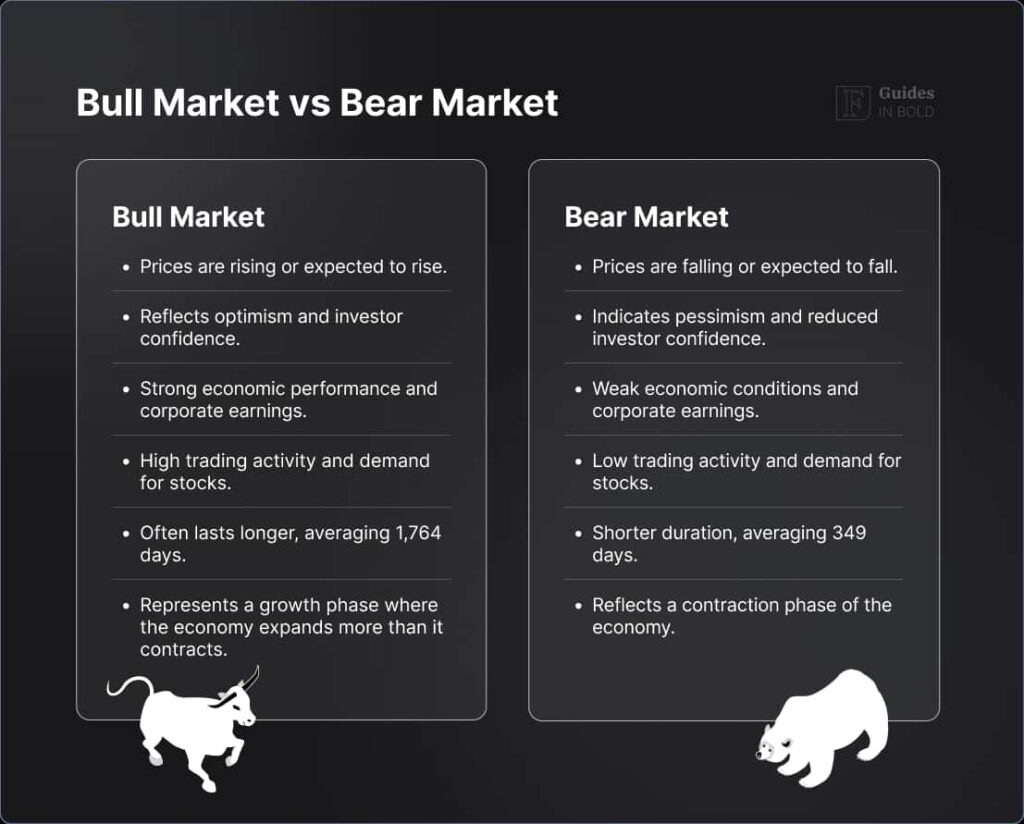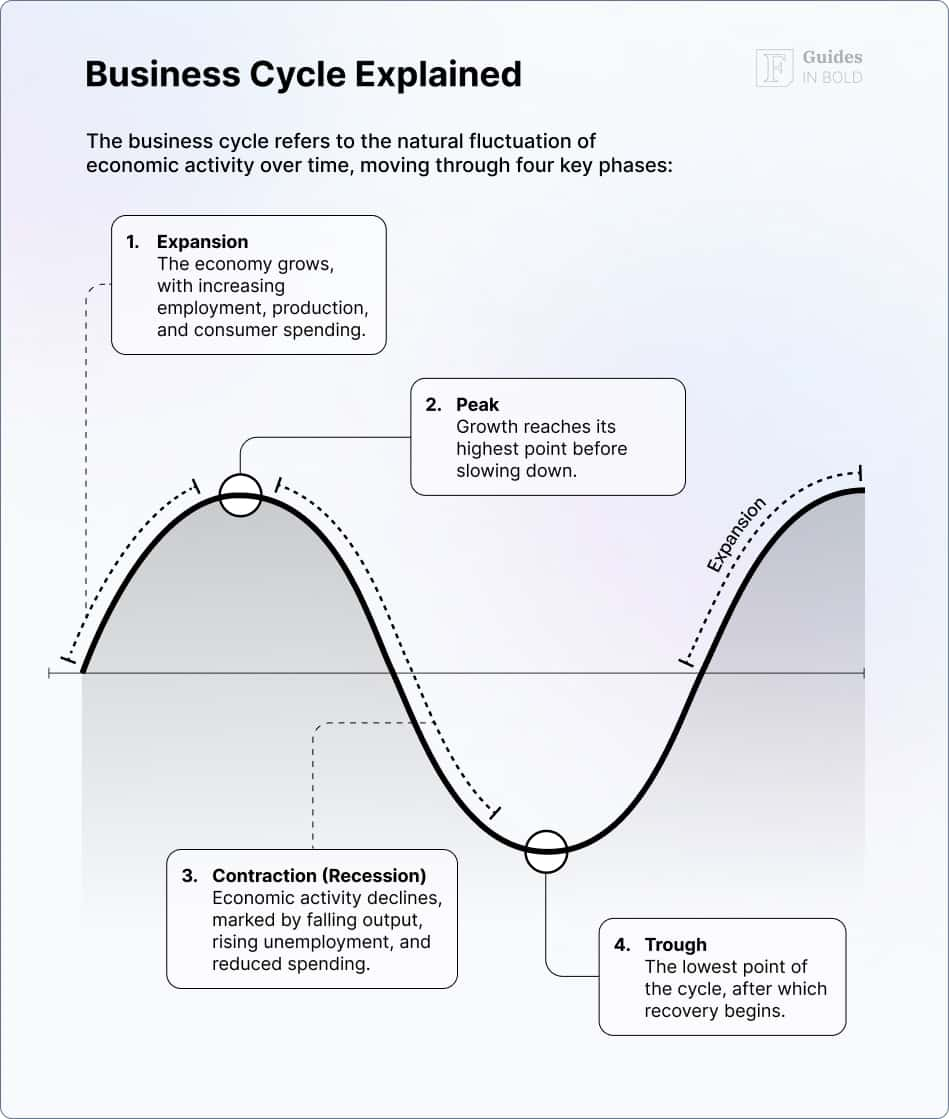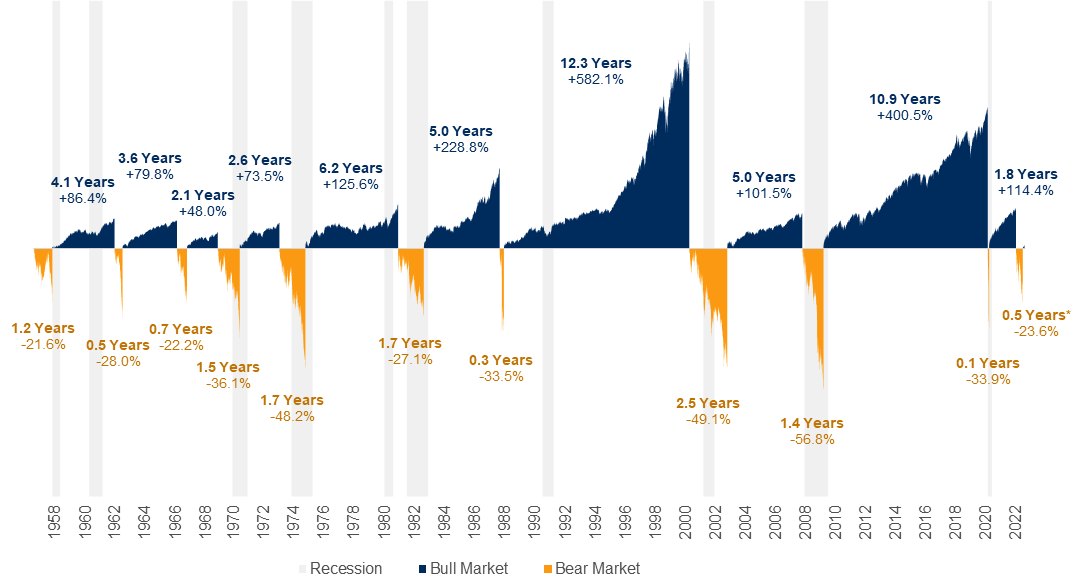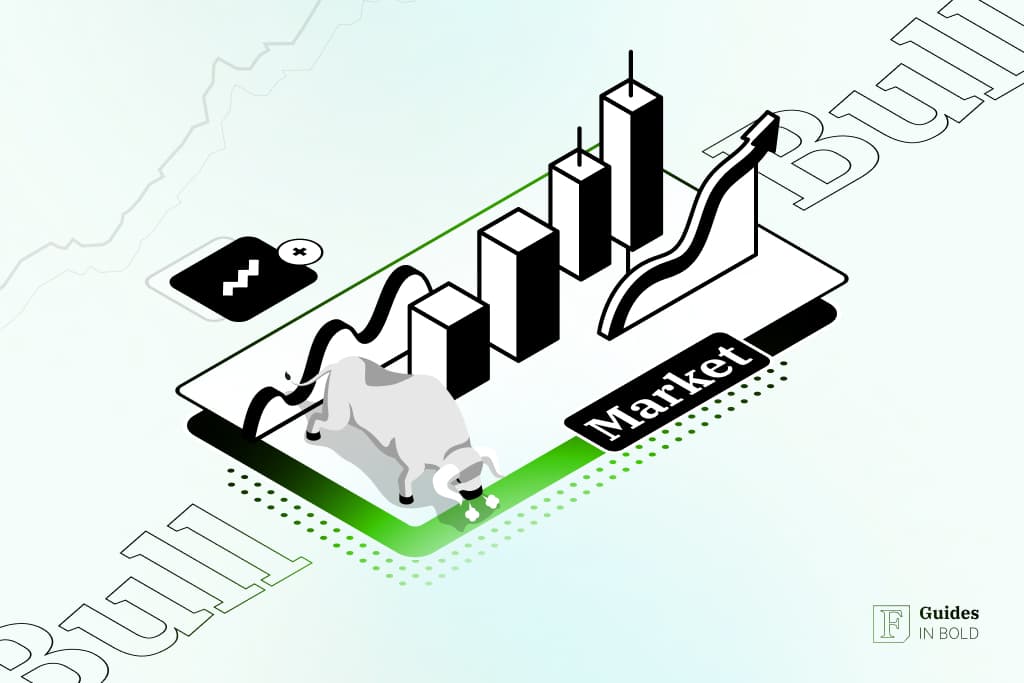In this post, we will define a bull market and explain what bullish investing behavior means. We will also look at different types of bull markets, their key indicators, and their characteristics. In addition, the main differences between bull and bear markets, define secular and cyclical bull markets, and discuss some investment strategies prevalent in a bull market.
Best Crypto Exchange for Intermediate Traders and Investors
-
Invest in cryptocurrencies and 3,000+ other assets including stocks and precious metals.
-
0% commission on stocks - buy in bulk or just a fraction from as little as $10. Other fees apply. For more information, visit etoro.com/trading/fees.
-
Copy top-performing traders in real time, automatically.
-
eToro USA is registered with FINRA for securities trading.
Summary
– Bull market definition: sustained price rise (20%+), high investor confidence;
– Driven by strong economy, low unemployment, low interest rates;
– Applies to stocks, crypto, gold, real estate, etc;
– Key indicators: rising P/E ratio, top-line (revenue), and bottom-line (profit) growth;
– Can be secular (long-term) or cyclical (short-term);
– Ends often confirmed only in hindsight;
– Opposite = bear market (falling prices, negative sentiment).
What is a bull market?
Moreover, a bull market doesn’t only apply to stock markets. It can also describe price fluctuations in sectors highly impacted by consumer confidence such as bonds, commodities like gold or oil, foreign currencies, real estate, or other asset classes. Any that pass through economic cycles and can either gain or lose value over time.
This term is thought to have come from the idea that bulls thrust with their horns upward, whereas bears swipe their claws downward. A bullish or bearish behavior – these metaphors indicate price fluctuation in the market.
Crypto beginners’ corner:
- How to Invest in Crypto? Complete Beginner’s Guide
- Best Cryptocurrency Exchanges – Top 7 Picks
- 15 Best Crypto Books for Beginners
- Must-read Crypto Wallets Guide for Beginners
- How to Mint & Sell NFTs? Beginner’s Guide
- How to Stake Cryptocurrency? Step-by-Step
- 11 Crypto Slang Terms Explained
- Best Crypto Trading Bots – Top 3 Picks
- What is DeFi? Liquidity Mining Explained
In a bull stock market, investor confidence is high, and there is a steady rise in stock prices. Or for commodities like gold or oil, a bull market would describe a steady increase in commodity prices.
Moreover, a bull market doesn’t always imply that all asset classes are in the same phase of their respective cycles. It is possible that certain sectors may fare well, while others will suffer losses. For example, real estate may be experiencing a bull market, while commodity prices may be experiencing a bear market. Although they are not always associated with a favorable economic climate, in general, they do.

How long do bull markets last?
Bull markets can last anywhere from months to even years and often coincide with the four phases of the economic cycle: expansion, peak, contraction, and through. The start of a bull market can also be an indicator of economic prosperity and growth.

It is impossible to predict the precise times a bull market will begin and end, and the exact dates can only be determined in retrospect.
Best Crypto Exchange for Intermediate Traders and Investors
-
Invest in cryptocurrencies and 3,000+ other assets including stocks and precious metals.
-
0% commission on stocks - buy in bulk or just a fraction from as little as $10. Other fees apply. For more information, visit etoro.com/trading/fees.
-
Copy top-performing traders in real time, automatically.
-
eToro USA is registered with FINRA for securities trading.
Are we in a bull or bear market?
The term bull market describes an upward price trend in the market, whereas a bear market describes declining prices. Investors can take bullish steps that drive up investment prices. Bearishly, investors would assume prices will fall and are thus more likely to sell, driving prices down.
The longest-ever bull market started in 2009 after the housing crisis, and it ended abruptly with a sudden Covid-19 pandemic-induced stock market crash on the 20th of February 2020.
However, global stock markets recovered at a remarkable rate, and the crash ended only a few months later, on the 7th of April 2020, when global stock markets entered a bull market again.
Since the financial crisis of 2008, the stock market has been growing. Despite some sharp decreases and market corrections along the way, prices reached an overall high. The global pandemic in 2020 reversed the trend, which has since managed to recover a bit.

Bull market indicators
A bull market usually means that there has been a 20% rise in prices over some time (from months to years), after a previous 20% decline, followed by another 20% decrease. If the prices rise or fall 10% or less, it is considered a market correction phase.
There are three key indicators that investors use to assess market conditions:
1. Price-to-earnings ratio (P/E)
One of the key indicators is the price-to-earnings (P/E) ratio. When the stock price to each dollar of earnings per share starts to rise, investors tend to start selling their shares because if the earnings drop, the P/E ratio rises. Monitoring the P/E helps investors make decisions on their investments.
2. Top-line growth
Top-line growth of top-line revenue (TLR) refers to a business’s gross turnover or revenues. If a company is experiencing high turnover, it means the company has top-line growth. Furthermore, top-line growth should usually increase in line with the GDP and is, therefore, a good measure to reflect demand. Conversely, business top-line growth shows the investment potential for investors.
3. Bottom-line growth
If businesses improve their profitability, it shows potential and encourages investors to buy their stocks, lured by a high return on investment. Usually, in a bull phase, several private companies choose to issue an initial public offering (IPO), driven by healthy economic conditions and high investor confidence.
Main characteristics of a bull market
An overall bull market may encounter dips along the road, referred to as market corrections, but in general, the underlying price trend will continue to rise. A number of indicators might point to the fact that we are in a bull market, and thus the following market characteristics are more likely to be seen during a bull market.
1. Overall economic stability
Bull markets often coincide with a strong economy and optimistic market sentiment; investors have a more positive outlook when inflation keeps a steady pace.
Therefore, the overall demand for stocks is also high. It can happen in line with strong gross domestic product (GDP) growth, as well as a drop in unemployment. However, usually, stock prices start rising before GDP growth, one of the key indicators to show how healthy the current economy is.
The chart below shows how bull markets can last for years, but the average growth remains around 6% throughout.

For example, the Covid-19 pandemic brought on the shortest ever recorded recession. Global lockdowns in 2020 contracted the GDP by 31%, a decline in GDP worse than during the Great Depression. But the economy made a speedy recovery, and by Q3 2021, the GDP growth was back to 2%, signaling continued economic expansion.
2. High investor confidence
Positive economic outlook and public sentiment drive up stock prices. If the overall economic situation is healthy, investor confidence coincides with it. As investors feel “bullish” about the market, they make bolder investments as investor confidence climbs in line with a bull market period.
High investor confidence in line with a stable economy will help the market to grow. If several investors feel positive about certain security, asset, or stock, it can create a movement caused by crowd psychology. It means that more investors would want to invest in particular stocks, which would, in turn, increase demand as well as prices.
3. High business profitability
A bull market is a reflection of the current economic and business environment. If an overall business climate improves, naturally, it raises more interest in investors. In a growing and healthy economy, companies tend to increase their bottom line and profitability. Therefore, more investors choose to buy.
What is more, during positive economic growth, more private companies likely issue an initial public offering, and an increase in IPO activity would then further grow a bull market.
But businesses may be overvalued on paper after the IPOs, leading to market corrections or even a bear market. For example, the overvaluation of tech stocks during the Internet boom caused a dot-com bubble between 1998 and 2000.
4. Lower interest rates
In a growing economy, banks tend to lower their interest rates on loans, and it encourages business and entrepreneurial activity and allows more companies to expand. When central banks like the United States Federal Reserve lower their interest rates, stocks become an attractive investment opportunity for more people.
As a comparison, in a recession, money usage by banks is curbed, and interest rates of loans go up, limiting investments and leading to a bear market.
5. International investments
During a bull market, investors are more confident (bullish) to invest internationally. They get encouraged in a bullish market to expand the existing portfolio.
Difference between a bull market and bear market
A bear market is the opposite of a bull market since a bear market is where prices of stocks, securities, or assets continue to decline over some time.
Bear market – substantial decline over a sustained period of time.
Bear markets represent negative sentiment in the market. Recession decreases investor confidence as corporate profits decline. Rising prices indicate a bullish market sentiment, whereas falling prices would show a bearish market sentiment.
In a bear market, the economy is in a recession. The GDP is falling over a long period of time, and stock prices are plummeting. Generally in line with the falling GDP, however, prices can start falling already prior. A bear market is typically defined as when stocks fall by 20% or more after a 20% peak.
Investors start selling their stocks, thus decreasing demand and increasing supply. As prices reach their peak, sell pressure begins, and investors begin seeking a way out. Investors start to focus on different investment strategies, such as short selling.
Similar to bull markets, bear markets can last for weeks to several months or even years. The most severe and longest ones to name are the Great Depression in the 1930s and the financial crisis of 2007-2008. Though, the average length is just under ten months.
Bull market examples
A bull market is a cycle in which prices continue to rise over a certain period of time. As an example, let’s look at some of the longest bull markets since World War II. Below, you can see the longest bull runs and their growth according to the S&P 500, including the most recent and longest one between 2009 and 2020.

1. Post-war boom – 1949 to 1956 (86 months)
The post-war bull market lasted for seven years between 1949 and 1956, when the S&P 500 gained around 266%. The United States experienced post-war prosperity with the Baby Boom and flourishing consumerism: cars, TVs, and new appliances became the norm in many households.
Later, the market crashed with the Suez Canal crisis and the Soviet Union’s invasion, causing a dip – a minor bear market amidst the S&P 500, which fell by 22%.
The image below shows a trend observed by the Dow Industrials between 1949 and 1956, presenting a zig-zag line but generally swinging upward over a long period. This trend includes numerous market corrections, as well as brief bear markets. However, the general trend was trending upward over those 86 months.

On the chart below, we can see a further close-up into the years 1949 – 1956 trend. It highlights where a bull market ends, and a bear market starts.

2. Ronald Reagan’s tax cut boom – 1982 to 1987 (60 months)
Stock markets were soaring between August 1982 and 1987, with the S&P increasing by +219%. Ronald Reagan cut taxes which initiated the steep increase in prices. The S&P 500 generated the best returns since the Great Depression, and unemployment was low.
This bull market ended as the market crashed in an instant in October 1987, with the S&P 500 falling by 22.6% within one day – a day labeled Black Monday.
3. Age of the Internet – 1990 to 2000 (113 months)
The Internet era in the 90s started the second-longest bull market to date. An era of prosperity that was driven by investors seeing potential in investing in tech companies. The S&P surged by over 400%, driven by economic growth and stable inflation.
After several investors bought stocks in dot-com companies, supply began to overtake demand. Share prices dropped as the Internet created buzz made investors hedge their bets and pour money into dot-com tech start-ups, which might have looked better on paper than in reality. Businesses went public without a proper business plan, product, or record of profitability yet still managed to secure investments.
Share prices weren’t longer justified, which caused a market crash in 2000. This boom ended with a bear market with a 49% S&P 500 decrease between March 2000 – 2002.
4. Longest bull market to date – 2009 to 2020 (131 months)
The longest-lasting bear market in history, longer than the one after the Great Depression, started after the financial crash in 2009. This market boom was driven by stable economic growth, soaring corporate profits, and low-interest rates. Unemployment was at an all-time low, and the quality of life was improving globally.
Further growth of the dot-com boom tech companies like Apple, Amazon, Facebook, and Google made them the most valuable companies in the US. The S&P 500 saw 334% gains over the course of 2009 and 2020.
Things abruptly ended when the Covid-19 pandemic-induced shock caused a major market crash in February 2020. Even though the bear market which followed was short-lived, the 2020 crash signaled a Covid-19 driven recession. However, already on the 7th of April 2020, markets re-entered a bull market showing signs of recovery.
What are different types of bull markets?
A bull market doesn’t only apply to stock markets, and it can also mean that prices are continuously rising for securities and assets like bonds, real estate, commodities, or currencies.
Let’s look at some of the main types of bull markets, briefly explain their characteristics, and bring some bull market examples.
1. Stocks
Three major stock market indexes are Dow Jones Industrial Average, the S&P 500, and the NASDAQ. Usually, all three would show signs of rising stock market indexes simultaneously, driven by economic health and investor sentiment.
2. Bonds
Bonds are a lot more stable and less dependent on market movements than stocks. There are fewer price increases and decreases and tend to be safer but also a more low-yielding investment option.
What is more, bonds have been in a bull market since the 1980s, meaning that their return on investment has been predominantly positive.
3. Gold (commodities)
A bull market is when prices in the market go up, and for gold, it means the same. A gold bull market, therefore, means that prices of gold continuously increase over some time. As opposed to stocks, gold is an investment less dependent on political and economic factors.
The first gold bull market occurred in the 1970s when Nixon ended the gold standard, and the price went from a mere $35 to a whopping $850.
The value of gold decreased as the gold bear market continued for the most part from 1987 to 2001, after which gold experienced some spectacular bull runs. Gold prices have been steadily increasing since 2015. In October 2024, gold reached an all-time high of $2,790.07 per ounce.

4. Cryptocurrency
Cryptocurrency space can also act differently from the general economic influences and investor sentiment. Since the first digital currency, Bitcoin, was introduced more than ten years ago, it has had a volatile trading history.
The previous major crypto bull market began in late 2020 and peaked in November 2021. During this period, Bitcoin surged to an all-time high of $68,789, while Ethereum reached $4,878.
As of January 2025, Bitcoin is trading around $96,451, and Ethereum is approximately $3,464. The current bull market, which started in 2023, has been driven by improving macroeconomic conditions, advancements in blockchain technology, and rising interest in tokenized assets.
What is a secular bull market?
A secular bull market trend lasts for anywhere between 5 – 25 years and can have several smaller bear markets within it. It happens frequently and is called primary market trends. Secular bull markets can experience several market corrections (10% decrease) along the way but keep sustained growth over a more extended period.
Difference between a secular vs. cyclical bull market
A secular bull market can last for longer periods, somewhere between 5 to even over 25 years. A cyclical bull market, on the other hand, generally lasts less than 5 years.
Investing in a bull market
People who want to benefit from a bull market have to catch on early. Investors should buy at the beginning of a bull market cycle to take full advantage of rising prices. Then, sell stocks at the right time before prices reach their peak and plummet. As with most investment strategies, there are risks involved, and it can be difficult to predict when prices will reach their peak.

There are several other types of investing strategies typical for a bull market. They often vary from bear market strategies due to more favorable market conditions. Having a higher stock allocation in a bull market is optimal as there can be more returns, whereas in a bear market investors remain more cautious.
Other strategies typical for a bull market include buy and hold, increased buy and hold, retracement additions, or full swing trading techniques such as short-selling. Short-selling allows investors to capitalize on cyclical bull market shifts in the context of a secular bull market but does require constant monitoring of the market.
Creating a sound financial plan can help avoid making decisions based on emotion. It is important not to let emotion drive investment decisions, as if people base their investments on a feeling that prices will keep rising, they are more willing to take hasty risks. Or make irrational decisions and sell stocks based on the fear that the market will crash.
In conclusion
Overall, no one knows when a transition from a bull market to a bear market is likely to happen. These shifts in the market can happen slowly over time, and the exact dates can be determined only in retrospect. Hence, it is hard to predict whether prices will continue to increase or when the market will crash.
However, understanding the general direction the market is going and general economic influences, one can have an idea of when and how to invest. And these moods, bullish and bearish behaviors, reflect the investors’ sentiment towards their own buying and selling behavior.
Disclaimer: The content on this site should not be considered investment advice. Investing is speculative. When investing, your capital is at risk.
FAQs about bull market
What does the term bull market mean?
A bull market is roughly defined as an upward trending line that continues to slope higher. During a bull market, investor confidence is strong, and they are willing to purchase stocks in the belief that they will appreciate in value. Originally, the term ‘bull’ referred to a speculative purchase made in the hope that stock prices would increase; the name was then given to the individual who made such purchases.
What is the difference between a bear and a bull market?
A bull market happens when the value of securities increases, whereas a bear market takes place when the value of securities decreases over an extended period of time. To make informed investment decisions, it is critical to grasp the distinctions between bull and bear markets.
What happens after a bull market?
When a Bull market comes to an end, a bear market follows, which is often characterized by equities dropping by 20% or more from their recent high. Dwindling market confidence, declining corporate profitability, and recessions are all common occurrences during Bear markets.
How do you profit from a bull market?
The ability to maximize the potential of the instruments available in any market is essential to achieving success. The use of long positions in stocks, ETFs, and call options is appropriate in bull markets and periods of strong market performance. Short selling, put options, and short or inverse ETFs, on the other hand, are appropriate for bear markets and allow investors to profit on the market’s downturn.
Are we currently in a bull or bear market?
As of April 2025, the U.S. stock market is approaching bear market territory, with the S&P 500 nearly 20% below its February peak. This decline is largely attributed to recent tariff escalations and growing recession concerns. While some analysts predict a potential recession, others believe any bear market could be short-lived. The situation remains fluid, and market conditions are evolving rapidly.





